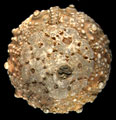| Type |
Cidarites scutiger Munster in Goldfuss, 1829, p. 121, by monotypy [=Echinus petaliferus Desmarest, in Defrance, 1825, p. 101]
|
| Species Included |
-
S. neocomiensis Cotteau, 1861; Barremian to early Aptian of France and England.
-
S. petalifera (Defrance, in Desmarest, 1825); Early to Late Cenomanian of Europe.
-
S. rugosa d'Archiac, 1847; Early Albian of England, Middle Cenomanian of France.
-
S. wilmingtonensis Smith & Wright, 1989; Early Cenomanian of England.
-
S. baylissi Smith & Wright, 1990; Late Cenomanian of England.
-
S. geometrica Agassiz, 1838; Coniacian to early Maastrichtian.
-
S, magnifica Wright, 1872; Late Santonian to early Maastrichtian; Europe and Former Soviet Republic.
-
S. sigillata Schluter, 1892; Late Campanian to Early Maastrichtian; Europe and Former Soviet Republic.
-
S. trigonata Agassiz; Santonian, France.
-
S. rejaudryi Arnaud; Campanian, France.
-
S. pesmei Arnaud; Campanian, France.
-
S. maxima Arnaud; Campanian, France
-
S. nutrix Peron & Gauthier; Maastrichtian, Algeria.
-
S. cossiae Peron & Gauthier; Maastrichtian, North Africa, Middle East, Arabian Peninsula, Iran.
-
S. hondoensis Cooke; Campanian, USA.
-
S. loveni Cotteau, 1888; Campanian, Sweden.
-
S. areolata (Wahlenberg); Campanian, Sweden.
-
S. lungreni Cotteau; Campanian, Sweden.
-
S. belgica Lambert; Maastrichtian, Europe.
-
S. anthrophora Muller; Maastrichtian, western Europe.
-
S. tumidula Clark, 1893; Paleocene, USA.
-
S. alta Hussan; Paleocene, USA.
-
S. cristata Fourtau; Middle Eocene, Egypt.
-
S. shencki Kaar; Lower Oligocene, USA.
-
S. cascadensis Linder et al.; Upper Oligocene, USA.
-
S. mooni Fourtau; Lower Miocene, Egypt.
-
S. pellati Cotteau, 1860; upper Eocene, France.
-
S. tandoni Srivastava, 1982; Middle Eocene, India
|
| Remarks |
Species in this subgenus have bigeminate or a mixture of bigeminate and unigeminate ambulacral plating. All have bigeminate plating adorally. Distinguished from Leptosalenia by having secondary perradial granulation down the centre of its ambulacra. Bathysalenia differs in having a dense pustular ornament over its apical disc and in always lacking sutural pits. Pleurosalenia differs in having unigeminate plating throughout.
Gray, J. E. 1835. On the genera distinguishable in Echinus. Proceedings of the Zoological Society of London, 3, 57-60.
Smith, A. B. & Wright, C. W. 1990. British Cretaceous Echinoids. Part 2, Echinothurioida, Diadematoida and Stirodonta (1, Calycina). Monograph of the Palaeontographical Society 101-198, pls 33-72 (publication number 583, part of volume 143 for 1989).
Mortensen, T. (1935). A Monograph of the Echinoidea. II, Bothriocidaroida to Stirodonta. C. A. Reitzel, Copenhagen
|



